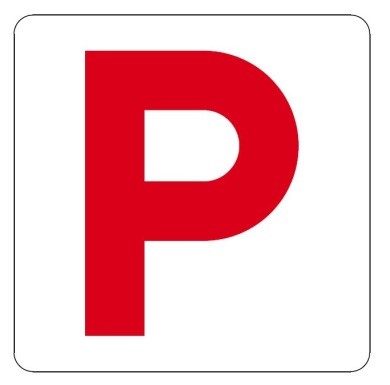 'P' plate for probationary rider of motor cycle or motor tricycle
'P' plate for probationary rider of motor cycle or motor tricycleMost of the rules and advice given to drivers in Chapter 5 apply to riders of motor cycles and motor tricycles.
Safety helmets
When you ride a motor cycle, you and your passenger must wear and securely fasten a safety helmet of approved type. Riders and passengers of motor tricycles should also wear the safety helmets.
A safety helmet will not protect you in an accident unless it fits properly. When buying a helmet, you should aim for the closest fit that causes no discomfort, even for long periods. Replace a helmet that shows signs of damage or after a hard knock even though there is no sign of damage on the surface.
Look after your helmet. It can be weakened by accidental knocks when not in use.
It is recommended that you replace a helmet after four years' use, as it becomes weathered and aged in that time, and cannot guarantee full protection in an accident.
Eye protection
Eye protection is the important function of visors and goggles. You are strongly advised to use a visor or goggles at all times when riding. Avoid poor quality plastic visors or goggles that scratch easily and make sure the lenses are shatterproof.
If riding in bright light is uncomfortable, use a tinted visor or goggles, or wear good quality sunglasses if they fit comfortably under your helmet. But do not use tinted helmet visors or goggles at night or in conditions of poor visibility.
Look after your goggles and visors with care. They can be ruined by scratches. Keep them clean particularly when riding at night.
Clothing
The clothing you wear when riding should
|
Wear light-coloured, reflective or fluorescent clothing. If you ride a motor cycle or motor tricycle as part of your job, ask your employer to provide you with suitable high visibility clothing.
Riding in hot weather in clothing such as shorts or short-sleeved shirts is not advisable, as your skin will have no protection in an accident if you fall and slide on the road surface.
Gloves should always be worn when riding, to protect your hands in an accident as well as for warmth. In hot weather, thin unlined gloves are the most comfortable and provide the best degree of control.
Wear strong shoes or boots.
Learner riders
If you are a new rider, enroll in a designated driving school to attend a compulsory training course. Having acquired the basic knowledge and skills to ride and manoeurve in an off-road environment and passed the written test as well as the competence test, you can then apply for a learner's driving licence. The licence enables you to practise on roads, with or without a licensed driving instructor, but you are not allowed to carry any passenger. When practising on roads, you must display approved 'L' plates at the front and rear of your motor cycle or motor tricycle.
You must not ride at certain times of the day. You must not enter or ride on a road to which the 'No learner drivers' sign applies. Information about these rules can be obtained from any Licensing Office of the Transport Department (see 'Further Reference Materials').
Probationary driving licence
Upon passing the driving test for motor cycle or motor tricycle, you are eligible to apply for a probationary driving licence and subject to additional driving restrictions. You can then apply for a full driving licence after satisfactory completion of the probationary driving period of at least 12 months.
(For rules, advice and information about the probationary driving licence scheme, see page 48)
 'P' plate for probationary rider of motor cycle or motor tricycle
'P' plate for probationary rider of motor cycle or motor tricycle